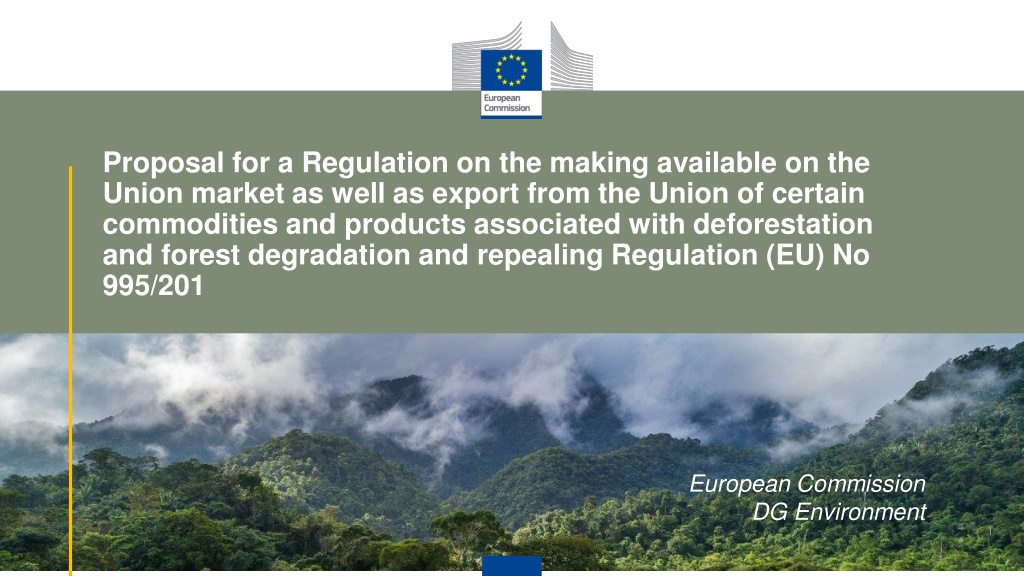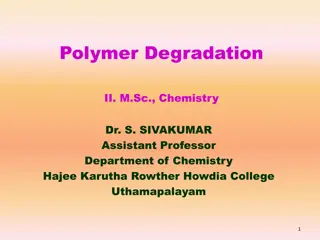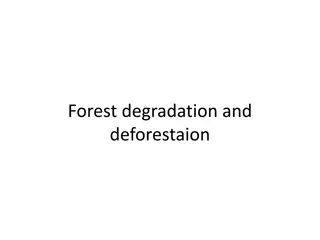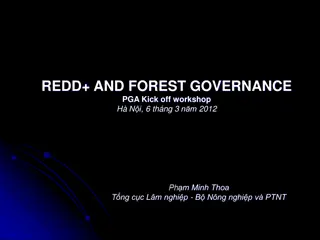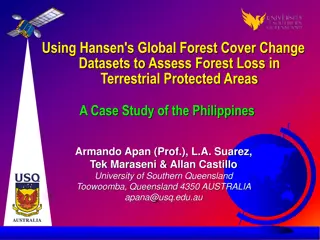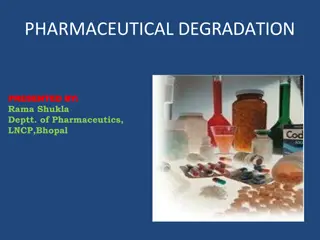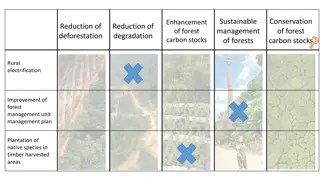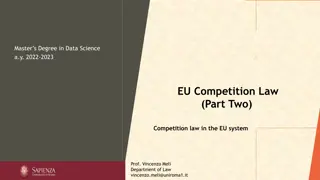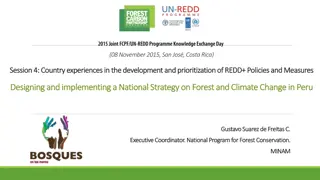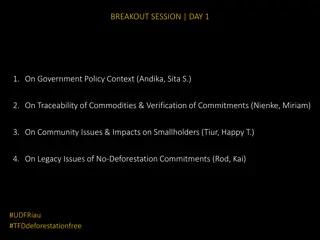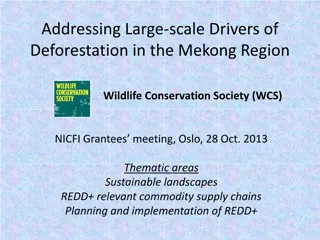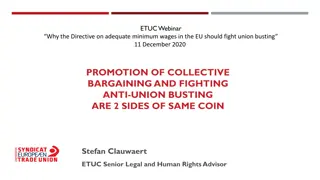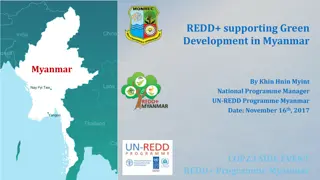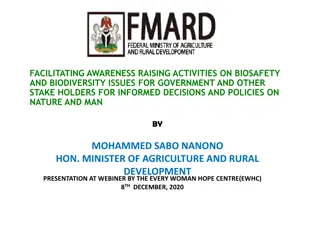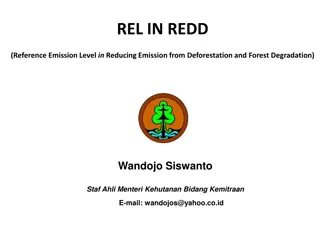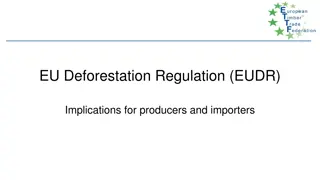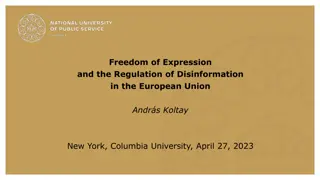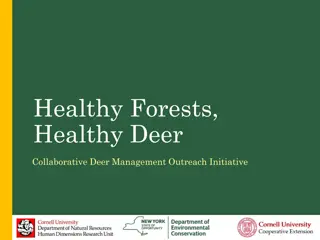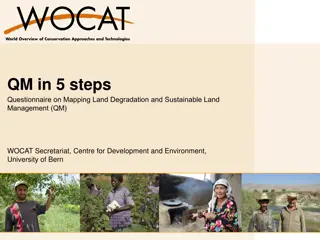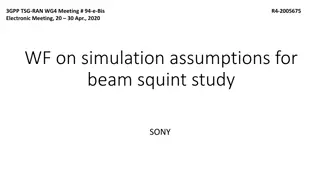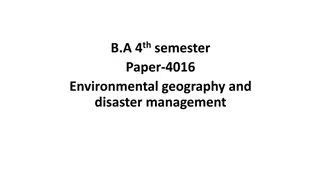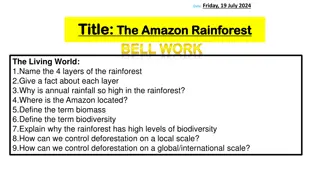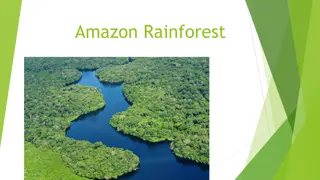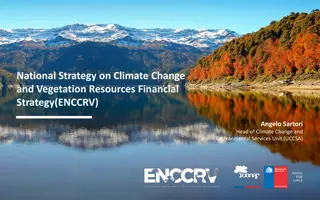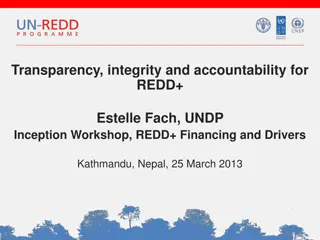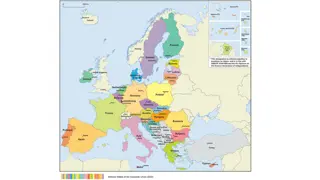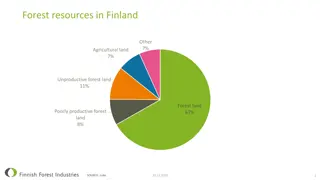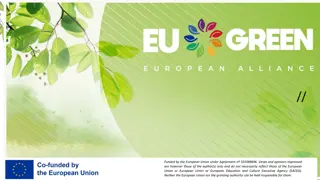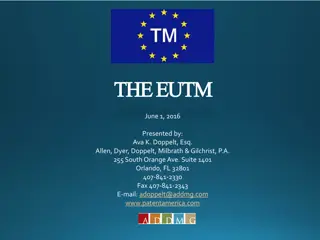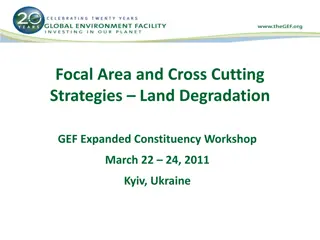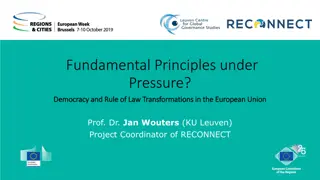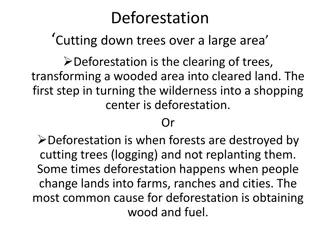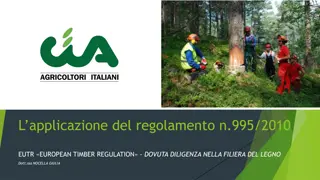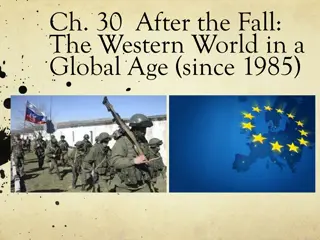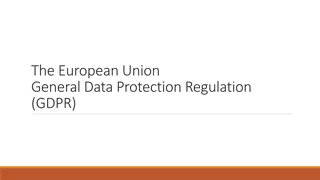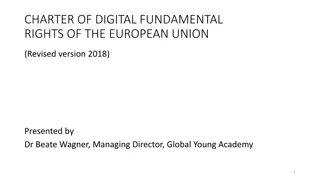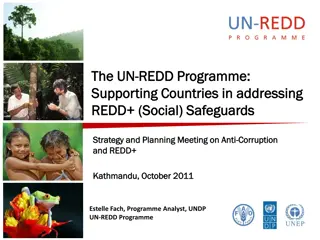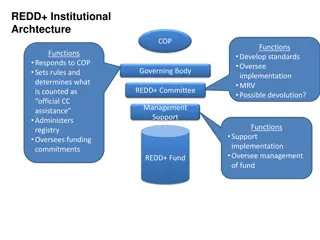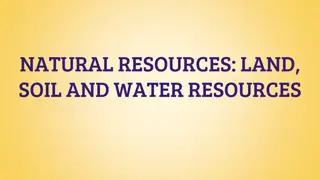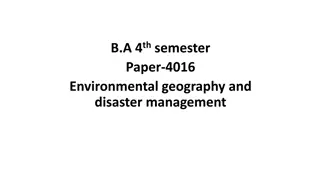Regulation Proposal to Combat Deforestation and Forest Degradation in the European Union
The European Commission is proposing a regulation to prevent the entry and export of commodities linked to deforestation and forest degradation. This aligns with political commitments such as the European Green Deal and the Farm to Fork Strategy. Existing legislation like the FLEGT Regulation and the EU Timber Regulation form the foundation for these efforts, with a focus on promoting imported products not associated with deforestation. The Timber Regulation Fitness Check highlights progress but also challenges in ensuring transparency and accountability in supply chains.
Download Presentation

Please find below an Image/Link to download the presentation.
The content on the website is provided AS IS for your information and personal use only. It may not be sold, licensed, or shared on other websites without obtaining consent from the author. Download presentation by click this link. If you encounter any issues during the download, it is possible that the publisher has removed the file from their server.
E N D
Presentation Transcript
Proposal for a Regulation on the making available on the Union market as well as export from the Union of certain commodities and products associated with deforestation and forest degradation and repealing Regulation (EU) No 995/201 European Commission DG Environment 1
Politicalcommitments European Green Deal EU Biodiversity Strategy Farm to Fork Strategy The Commission will take measures, both regulatory and otherwise, to promote imported products and value chains that do not involve deforestation and forest degradation. The Commission will also present, in 2021, a legislative proposal and other measures to avoid or minimise the placing of products associated with deforestation or forest degradation on the EU market. [ ], the Commission will present in 2021 a legislative proposal and other measures to avoid or minimise the placing of products associated with deforestation or forest degradation on the EU market. 2
Political commitments European voters and consumers are making this increasingly clear to us: They no longer want to buy products that are responsible for deforestation or forest degradation. This is why we will soon propose a regulation to tackle EU- driven global deforestation. Commodities and products placed on our market should not lead to deforestation. But we will do that with a principle to working in close partnership with the producing countries. This is so important. President von der Leyen 2 NOV, COP26 Glasgow 3
Existing Legislation Regulation (EC) No 2173/2005 of 20 December 2005 (the FLEGT Regulation) allowing for the control of the entry of timber to the EU Regulation (EU) No 995/2010 of the European Parliament and of the Council of 20 October 2010 (the EU Timber Regulation) prohibiting placing of illegal timber and timber products on the internal market. Regulation (EU) No 2017/821 of 17 May 2017 laying down supply chain due diligence obligations for Union importers of tin, tantalum and tungsten, their ores, and gold originating from conflict-affected and high-risk areas. Directive No 2014/95/EU of 22 October 2014 amending Directive No 2013/34/EU as regards disclosure of non-financial and diversity information by certain large undertakings and groups 4
Timber Regulation Fitness Check Main findings : EUTR has led to significant improvements in raising awareness and transparency of information in the supply chains The DD requirement can be implemented regardless of the size and activities carried out by the operator from forest owners to international corporations; However Exports from countries with known issues of illegal logging (e.g. Ukraine, Myanmar and Belarus) continued and actually grew over the last years EUTR implementation has varied across the EU Challenges for operators is the ability to validate information obtained from their supply chains 5
Timber Regulation Fitness Check Main challenges, specifically on the design and application of DDS: There is limited understanding of the concept of DD in some MS legal systems, in particular definitions at the core of DD . Additional tools might be necessary to overcome these difficulties. The absence of a clear definition of negligible risk impedes the EUTR s implementation and enforcement, because it affects the gathering and interpretation of information needed to prove that a risk is negligible for operators, Competent Authorities (CAs) and the courts. The transposition of the DD requirements into national legislation has been challenging in some MS. This has created difficulties for CAs to successfully pursue cases in courts. Difficulty in challenging inadequate DD in court has led to CAs hesitating to initiate prosecution. 6
Impact Assessment Options discarded after the viability screening: Voluntary labelling, voluntary due diligence, voluntary private certification, voluntary partnership agreements, mandatory information disclosure. VPA approach: Based on legality, not compatible with the approach based on a definition of deforestation-free (not up for negotiation). Serious shortcomings detected in the Fitness check would be even more pronounced, including even larger resource and continued lack of willingness of major producing countries to engage. Private certification: Varying levels of transparency, different rules and procedures as well as different quality assurance systems. Concerns over the efficiency and integrity of chain of custody (CoC) systems and the lack of independent audits. SMEs at a disadvantages regards costs. 7
Scope Commodities selected: Palm oil, soy, wood, cattle, cocoa, and coffee and some derived products (e.g. leather, chocolate, furniture) The Regulation applies both to domestically produced and imported commodities and derived products. Progressive scope - Initially covering selected commodities and derived products; To be updated regularly; Cut-off date of 31 December 2020: Commodities not allowed to enter the EU market if produced on land subject to deforestation after that date. 8
Impact Assessment An initial analysis of approximately 20 options resulted in the following options that are shortlisted for further analysis: 1) Mandatory due diligence 2) Mandatory due diligence with country benchmarking 3) Mandatory due diligence with mandatory public certification 4) Mandatory due diligence with mandatory labelling 5) Public certification combined with country benchmarking (IUU system) 9
Objectives GENERAL Minimise the EU s contribution to deforestation and forest degradation worldwide (thus reducing EU-driven GHG emissions and biodiversity loss) Specific Minimise the risk that products coming from supply chains associated with deforestation or forest degradation are placed on the EU market Increase EU demand for and trade in legal and deforestation free commodities and products 10
Main elements [1] Mandatory due diligence rules for all operators that place the commodities and products on the EU market or export them from the EU Only products that are both deforestation-free and legal according to the laws of the country of production would be allowed on or exported from the EU market, and are covered by a due diligence statement Based on existingdefinitions (coming from EU legislation i.e. RED and from international work esp. FAO) Strict traceability linking the commodity to the plot of land where it was produced Information system: Host due diligence statements and related information to facilitate enforcement by Member States. 11
Main elements [2] Benchmarking system that allows to assign risk to countries according to the level of risk of deforestation [low, standard, high] Specific obligations for operators and Member State authorities simplified due diligence for low-risk and enhanced scrutiny for high-risk countries Minimum level of inspections for Member States authorities to perform Effective, proportionate and dissuasive penalties 12
Main elements [3] Cooperation with partner countries Imports of the commodities and products covered - EUR 60 billion / year No ban against any country or commodity The Commission will step up cooperation programs to ensure that EU partners are able to reap the benefits of new EU rules on deforestation The new Forest Partnerships are a key tool in this regard The Commission will also intensify engagement with consumer countries such as China and USA as well as in international fora. 13
Key messages The Regulation aims to enhance trade in products from deforestation-free supply chains. This proposal is an opportunity to jointly create more sustainable supply chains and take action against deforestation and forest degradation. The regulation imposes obligations on operators and traders aiming to place the commodities and products in scope on the EU market. It will have an impact on suppliers in their supply chain whether in the EU or in partner countries. The EU is ready to work closely with and support the partner countries efforts to create deforestation-free supply chains. The Regulation is based on the following principles: Transparency, accountability and sound scientific and methodological basis Consistency with agreed international commitments, notably halting deforestation at the levels of December 2020 in line with SDG 15 Non-discrimination, as it equally treats domestic and imported commodities and products and covers both imports and exports. 14
Key messages The Regulation is part of a broader set of policies. It will be implemented hand-in-hand with other measures including, where appropriate and feasible, support to producing countries, dialogue with other large consumer countries and cooperation at international level, especially in the relevant multilateral fora. Partnerships and cooperation are important to promote the transition to sustainable agricultural production, sustainable forest management and the development of transparent and sustainable supply chains, as well as continue efforts towards identifying and agreeing robust standards and definitions that ensure a high level of protection of forest ecosystems. The Commission will therefore engage with producer countries concerned by the Regulation to jointly address deforestation and forest degradation and make sure that they are ready to adapt to the incoming new EU rules on deforestation. This engagement will include structured dialogues with partner countries, administrative arrangements and provisions in existing agreements or agreements that support producer countries to make the transition to an agricultural production that facilitates the compliance of relevant commodities and products with the requirements of this regulation. 15
Chapter 1: General Provisions Article 1: Obligations for operators placing on the EU market and exporting from the EU market (thus including export to address gap identified in EUTR) Relevant commodities and products as listed in Annex I Not applicable to commodities and products placed on the Union market before the entry into force of the Regulation Article 2: Definitions Definition of deforestation : Builds on FAO: conversion of forest to agricultural use, whether human-induced or not Definition of forestdegradation has two parts andexplicitly focuses on harvesting operations : aligned with FAO State of the World s Forest Report 2020 building on sustainability criteria of REDIII Cut-off date of 31 December 2020: Based on UN Sustainable Development Goals (15.2., halting deforestation by 2020) 16
Chapter 1: General Provisions Article 3: Prohibition Products cannot be placed on the market or exported, unless they are Deforestation-free : Major step forward vis a vis EUTR, aiming at covering gaps (a lot of deforestation is legal), facilitating implementation (satellite monitoring), preventing harmful incentives in third countries (race to the bottom) and increasing the overall effectiveness of Regulation; Legal: As in EUTR, covering national applicable laws and international treaties in the country of production; and covered by a Due Diligence statement: New requirement (contained in U.S. Lacey Act, but not EUTR), aimed at facilitating court action, improving traceability and providing information to competent authorities to enforce the Regulation, and ensuring awareness of the law among operators 17
Chapter 2: Obligations of operators and traders Article 4: Obligations of operators - operator is responsible for the compliance of the relevant commodity or product and may not place commodities/products on or export from the market if: No due diligence statement was submitted the commodities/products are found to be non-compliant the exercise of due diligence revealed that the risk of non-compliance is non-negligible (e.g. for lack of information on the origin of the commodities or products) the operator was unable to complete a due diligence procedure as required information is not available; . Operator has an obligation to act when receiving information, including substantiated concern, on possible non-compliance Article 5: Authorised representatives: operators or traders may mandate representatives to make due diligence statement on their behalf, however the legal responsibility remains with the operator Article 6: Non-SME traders are subject to obligations to certain operator-specific obligations (major difference vis a vis EUTR to avoid loopholes) Article 7: If operator is based outside the EU, first buyer within the EU is considered operator (new clause vis a vis EUTR to avoid loopholes) 18
Chapter 2: Obligations of operators and traders Article 8: Basic structure of due diligence procedure: information requirement, risk assessment and risk mitigation Article 9: Information requirements step one of due diligence Geographic coordinates (geolocation) linking the commodities to the plots of land where they were produced (inputs received from DGs); identification of the country of production; Information to be provided to the CAs upon request Article 10: Risk assessment and risk mitigation steps two and three of due diligence Criteria for risk assessment (prevalence of deforestation, reliability of documentation, corruption, conclusions of Expert Group, etc.) Certification and third-party verified schemes: Can be used to provide complementary information, but: Operators remain legally responsible Information supplied by certification schemes needs to meet information requirements of the Regulation (e.g. geolocation) Products covered by valid FLEGT licenses: Presumption of legality, unless substantiated concerns are raised 19
Chapter 2: Obligations of operators and traders Article 11: Obligation to : reviewing due diligence system annually and adapting if necessary; reporting publicly every year (including in the context of other reporting obligations), not applicable for SMEs, . Article 12: Simplified due diligence; operators placing on or exporting from EU market from low-risk countries or parts thereof do not have to perform risk assessment/mitigation actions set out in Article 10. However obligation to act, if made aware of concerns. 20
Chapter 3: Obligations of MS and their competent authorities Article 13: Member States Designation of competent authority Provision of technical and other assistance to operators, especially to SMEs; Exchange and dissemination of relevant information. Article 14: Obligation to perform checks Obligations to establish a plan based on a risk based approach, taking into account country risk category Obligation to perform risk analysis based on due diligence statements Checks and inspections should cover (innovation from EUTR): At least 5% of the operators At least 5 % of the quantity of each of the relevant commodities placed or made available on or exported from their market Obligation to take interim measures ( Art. 21 ) where immediate action is needed Custom authorities are required to facilitate information (innovation from EUTR) and use information system established under the Regulation Article 15/16: Content of inspections (due diligence systems, documentation records and, if necessary, field audits, satellite tools, isotope testing, field audits, etc.) 21
Chapter 3: Obligations of MS and their competent authorities Article 17: Cooperation and exchange of information (obligations need to cooperate with other CAs and with customs authorities as well as with the EC) Article 19: Reporting obligations Annual reports on application; EC to publish annual overview Article 20: Enhanced scrutiny For commodities and products produced in a high risk country or parts thereof: checks shall cover at least 15% of the operators placing, making available on or exporting from the Union market each of the relevant commodities as well as 15% of the quantity of each of the relevant commodities Article 21: Interim measures Based on checks or risk analysis, CA can take immediate interim measures 22
Chapter 3: Obligations of MS and their competent authorities Article 22: Market surveillance measures Once non-compliance established CA are obliged to require the relevant operator or trader to take appropriate and proportionate corrective action, including: rectifying any formal non-compliance preventing the relevant commodity or product from being placed, made available on or exported from the Union the market Immediate withdrawal or recall destroying the relevant commodity or product or donating it to charitable or public interest purposes Article 23: Penalties: MS shall establish as a minimum (evidence from Fitness Check of EUTR pointed to lack of dissuasive power of penalties): Fines proportionate to the environmental damage MS cannot set a maximum amount of penalties below 4% of company turnover Temporary exclusion from public procurement 23
Chapter 4: Rules relevant for entering or leaving the Union market Articles 24 and 25: Controls roles of custom authorities and obligation to exchange information between customs and competent authorities Article 26: Electronic interfaces The Commission will develop an electronic interface based on the EU Single Window Environment for Customs(once available) The operators and traders may submit the due diligence statement via national single window environment (once available) 24
Chapter 5: Country benchmarking system and cooperation with third countries Article 27: Assessment of countries Countries or parts thereof may be assigned three categories: low, standard and high risk Initially all countries are considered standard risk Assessment of risk based on criteria: rate of deforestation rate of expansion of agriculture land for relevant commodities production trends of relevant commodities and products whether the country s NDCs covers emissions and removals from agriculture, forestry and land existence of relevant agreements and other instruments concluded between the country and the Union national or subnational laws in place, including in accordance with Article 5 of the Paris Agreement, and takes effective enforcement measures Provisions on notification and cooperation with country affected by a possible change in risk status 25
Chapter 5: Country benchmarking system and cooperation with third countries Article 28. Cooperation with 3rd Countries : Engagement with producer countries concerned by this Regulation to develop partnerships and cooperation to jointly address deforestation and forest degradation, which may include structured dialogues, support programmes and actions, administrative arrangements and provisions in existing agreements or agreements; Engagement in international bilateral and multilateral discussion on policies and actions to halt deforestation and forest degradation, including in multilateral fora, which shall include the promotion of the transition to sustainable agricultural production and sustainable forest management as well as the development of transparent and sustainable supply chains as well as continue efforts towards identifying and agreeing robust standards and definitions that ensure a high level of protection of forest ecosystems; 26
Chapter 6: Substantiated concern Article 29: Natural or legal persons substantiated concerns Any person is entitled to submit substantiated concerns to CAs regarding breaches of the Regulation Competent authorities are required to analyse the concern and inform the claimant of their follow up Article 30: Access to justice Possibility to ask for review of the procedural and substantive legality of the decisions, acts or failure to act of CAs 27
Chapter 7: Information system Article 31: Register information system An information system to host due diligence statements and other relevant information (innovation with regards to EUTR, building on its shortcomings)to facilitate: access to relevant information for competent authority to allow for risk-based checks targeted inspections (e.g. concerning large shipments of a precise municipality affected by deforestation in a given country) The provision of anonymised datasets to be shared with the wider public following open data guidelines, in order to foster transparency links with Customs Single Window and with national systems Operation and functionalities to be specified further in an implementing act 28
Chapter 8/9: Review and Final Provisions Article 32: Review First review within two years after entry into force will look at extension of the scope of this Regulation to other ecosystems, including land with high carbon stocks and land with a high biodiversity value such as grasslands, peatlands and wetlands and further commodities. First general review within five years after entry into force will in particular look at the need for and feasibility of additional trade facilitation tools to support the achievement of the objectives of the Regulation including through recognition of certification schemes as well as the impact of the Regulation on farmers, in particular smallholders, indigenous peoples and local communities and the possible need for additional support for the transition to sustainable supply chains, while A first review of the range of goods listed in Annex I will take place within two years after entry into force by way of a delegated act. Article 35: Repeal of the EUTR Article 36: Entry into force and date of application Entry into application of certain provisions one year after entry into force Two years delay for micro-enterprises established by December 31, 2020, except for products covered by EUTR 29
Annex I Contains the list of goods as classified in the Combined Nomenclature set out in Annex I to Council Regulation (EEC) No 2658/87, referred to in Article 1 of this Regulation1, which are subject to the requirements of this regulation Exemption for recycled products. 30
Outlook Rules on Civil Liability of operators are missing ! Broader Context of the EU Agenda for empowering consumers and more general rules on sustainable corporate governance still work in progress, but focusing on further strengthening of consumer protection against green washing and setting minimum requirements for sustainability labels, logos and information tools; Proposal on sustainable corporate governance with a view to incentivise corporate boards to integrate properly stakeholder interests, sustainability risks, dependencies, opportunities and adverse impacts into strategies, decisions and oversight in order to to identify, assess and mitigate adverse impacts in the value chain. 31
Thank you! Learn more here: https://ec.europa.eu/environment/publications/proposal- regulation-deforestation-free-products_en 32 .
